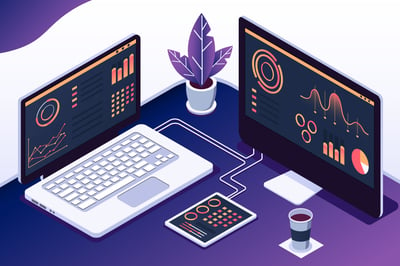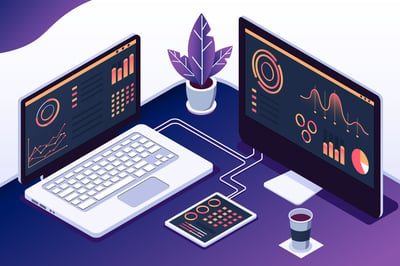July 30, 2023
 by Priya Khaira-Hanks / July 30, 2023
by Priya Khaira-Hanks / July 30, 2023

Your organization’s digital offering - its software interfaces, websites, and applications - is expected to evolve quickly and perform more efficiently than ever.
Why the pressure?
In recent years, cloud computing vendors have commoditized vast computing resources and made them easily accessible, for a price. Therefore, all organizations are raising the game.
Greater computing has led to faster development cycles and ever-complex applications that end users can consume in myriad ways. This has increased consumer expectations, with users expecting more complex and ever-changing applications to meet their needs. The computing power at our fingertips has enabled a digital transformation race.
In this environment, application servers are key to meeting consumer demands and ensuring your digital offering remains ahead of the curve.
If you are a large organization in any sector with a digital presence, chances are you are operating enterprise applications that could be improved, future-proofed, and made to increase their return on investment with an enterprise application server.
First, understand that you are likely to be operating enterprise applications. To understand what this means, we look at how an application is used and how complex it is.
An enterprise application is used for a non-trivial purpose; it is developed by an organization to solve a specific problem for a given target market in return for some value. It is used by customers or internally within the organization for the eventual benefit of customers.
You may hear it described as "mission-critical."
It could be anything from the e-commerce platform through which you sell your products to something within the products themselves, like in-car automotive software. It could be the system used to process customer orders at a food outlet, used by staff, or the CRM system when selling a service.
However, it is not just how it is used that makes the application "enterprise," but its structure.
An enterprise application, by necessity, is complex. A typical enterprise application has three tiers: the user interface (UI), the middle layer, and data storage.
Source: Payara Services
The UI is where the end users interact with the application. This is the web page or application as it appears on your phone; the screens that users will be navigating to use the application to solve the problem it was designed for.
For workers in a pizza restaurant using software to process customer orders, the UI refers to the screen with images of menu items that correlate to pricing. For drivers using connected cars, the UI is the in-car screen controlling different functions within the vehicle.
Each enterprise application will operate on vast banks of data. Depending on the task, this could be about users, products, other software components, or external information.
For a pizza restaurant, there is data pertaining to staff, deals, individual orders going through, products - and on a wide scale, different stores, financials, and stock levels. A data storage mechanism will feed into the UI - interacting through the third tier, the middle layer.
This data could be hosted on physical servers or managed cloud servers.
The middle layer is the software connective tissue between the UI and the data storage.
It handles interactions with the data storage: when a user needs to retrieve data, the middle layer manages the processes around locating it and returning it to the user.
The middle layer deals with a whole host of infrastructure tasks that do not relate to the actual specifics of what your application is doing but are essential to it operating at scale.
These include security, interactions with other services, internet connection, managing resources, etc.
These tasks can be understood as the moving parts between the data that feeds into an application and the UI that the customer sees and are sometimes referred to as the behind-the-scenes “plumbing” of an application.
It is regarding this middle layer that your application server comes in.
An enterprise application server can take care of your middle-layer tasks. It is software that sits in between your data storage and UI. Instead of coding each middle layer job separately - retrieving information, responding to user requests, ensuring new data is stored, and using your compute resources efficiently - you can integrate the application server into your system to handle it all.
A key job of the middle layer is handling user requests. These requests take the form of hypertext transfer protocol (HTTP) requests, as HTTP is the most important procedure used on the internet for communication between different machines.
For example, your user will request your application to retrieve or update information.
A worker in the pizza restaurant will ask for a particular pizza to be added to a customer’s order. They may not know this, but this will mean the complex enterprise application needs to update items in the database about stock, as well as store the single customer order.
It may also need to interact and change information in other linked applications, like a driver allocation application or stock shipping.
HTTP is a standardized protocol for communicating changes within the application and with the software it is externally interacting with, in this case, between the UI, data storage, and other interlinked applications.
HTTP indicates what must happen within the software and controls the data transfer.
Your application server’s chief job is handling these HTTP requests, but it will do much more. It will take on all the tasks associated with the middle layer. This includes:
You might have heard about web servers. These differ from application servers in that they only handle HTTP requests.
You will need to develop a lot of the basic functionality and infrastructure code yourself, which is not an ideal way to build applications. They still handle the more low-level details, but a full application server has additional features to make developing applications easier and faster, so you don’t need to manually deal with the low-level stuff.
Applications servers greatly expand the ability of a web server.
There are several benefits of using an application server. Some of them are outlined below.
Many infrastructural tasks come with running an enterprise application. These include the HTTP processing outlined above.
An application server provides code for these enterprise-specific tasks, so your developers don’t have to write it themselves. Often coding for these tasks is time intensive and does not relate to what you want your application to do or how you want to improve it.
You can use your developers more efficiently by outsourcing these tasks to the application server.
Rather than expending developer time creating solutions for the basic mechanisms of an enterprise application, concentrate your people resources on the tasks that will elevate your application and keep up with the fast-moving digital transformation of the modern age.
Taking care of infrastructural tasks so your developers don’t have to is the basis of the Jakarta EE model.
Jakarta EE is a set of industry-standard software components, or APIs that work with an application server and the Java programming language to complete those key enterprise infrastructure tasks.
This doesn’t just save time. Your application’s business functions are now separated from infrastructural tasks. Complexity is hidden, and your developer’s working experience will be cleaner.
As an enterprise application is critical to your business success, it mustn't fail.
Availability refers to the length of time a system can operate without fail. High availability is when a system meets or even exceeds what is required of it in terms of length of time without failing and is associated with high operational performance.
While the standard for time without failure will differ depending on the system, using an application server is associated with high availability.
This is because your application server will accept and manage HTTP requests. If there is a failure in a request being met, your application server can redirect it to existing, working parts of the network. This is called load balancing.
How an application server spans an application allows it to allocate requests to ready resources, ensuring connections are always available for demands.
There are also opportunities for an application server to store a user’s session data in the case of a failure, recovering it and allowing the session to continue with minimum disruption. In short, an application server reduces the chance of snags in the system, resulting in a smoother user experience.
An operating system is a single program to manage other different programs, simplifying the user experience and creating a cohesive system to navigate via a single tool.
Without an application server, different functionalities within the middle layer of an enterprise application would operate and be accessed separately.
The web server would be its own tool, to be operated with its frameworks and rules; this would be separate from your security infrastructure and load balancing.
Different application elements would require complex code to interact with each other and would also be more intricate to monitor. Developers would need to be trained in the languages and tools used for each different functionality.
The application server circumnavigates this complexity by behaving as an operating system - a single, connective source of truth for the many different functionalities it carries out for you.
Cloud native, though often contested as a term, is widely taken to mean an approach to building and running applications that takes advantage of the compute resources on demand offered by cloud vendors.
In cloud-native applications, infrastructure is more likely to be defined by software rather than on-premises environments. Your infrastructure is elastic and can contract and expand rapidly.
Application servers are even more important in this context, as they can automate the processes involved with moving to a public cloud provider.
Expanding and contracting your infrastructure in response to demand is only useful if it can be automated and managed effectively. Your application server has the power to manage this process.
Most modern application servers are built to thrive in cloud-native environments. If you choose an application server, you can access in-built server optimization options for cloud-native processes.
Your application server will be primed for containerization (virtually bundling myriad components of an application), clustering (different connected virtual machines working together), and the ability to store data in one part of your cloud-hosted system and retrieve it from another.
All these capabilities will make a more efficient system for your users.
Security is a key concern for enterprise applications, vital to business productivity, and because they are likely to deal with confidential user, employee, and company data.
You need to ensure that the application has the intended functionality executed by the appropriate people. You need to ensure that data updates are restricted and that end users only see data they are allowed to see.
Application servers contain features to ensure your data remains safe.
For example, application servers will come with in-built options for authentication: ensuring that only officially allowed (authenticated) end users can work with your application.
Application servers contain ready-to-go code to identify your users through a username and password or two-factor authentication. They often have prebuilt integrations with tools to outsource the identification process, for example, OpenIdConnect flow.
After authentication, the application server knows who the end user is and can correlate it with a unique identification stored for them. Coding an authentication solution would be your developers’ responsibility without an application server.
When using an application server, you benefit from a product planned and implemented by an expert team of engineers.
Not only will the software be regularly updated, with improvements, bug fixes, and updates, but you can use their expertise directly if you choose a support option. Many application servers offer migration, project, and ongoing support via tickets and hotlines.
This can bring peace of mind, which isn’t possible when working with your own infrastructure. You will have a bank of experts, specialized in the functionalities associated with the middle layer, ready to call on when needed.
This allows you to focus on hiring developers with the skills essential to the business function of your app and free up developer time for innovation. It’s also likely to save money in problem-solving in the long term, with server experts able to correctly identify issues as they arise.
Application server support is likely to be an extra, paid option. Even if you don’t need it immediately, whether it is offered is a crucial consideration as you choose your stack, especially if you plan to scale up.
Choosing the right application server is not an easy task. Here are some guidelines to keep in mind during the process.
As outlined above, one of the key advantages of an application server is that it will save your developers time and effort. Therefore, it must be accessible and easy to use.
The easier it is to get started with a development platform, the faster developers can get to work, and the server will start delivering business value.
Contributing to ease of use is a good user interface: consistent, clear, and intuitive to use. Also crucial is thorough documentation, with reference documents, how-to guides, and video tutorials not only plentiful and covering all aspects of usage but up to date and well designed.
An application server will also have lower barriers to entry if it uses common frameworks. If the tools it can use are wide-ranging and varied, and the frameworks it is built on are popular, it is more likely to quickly and easily fit in with your current stack.
When you are investing in an application server, it is important you choose one that is stewarded by an organization.
Usually, a private company will operate an application server, offering a paid-for supported version and a free version. A not-for-profit software outfit like the Eclipse Foundation or the Apache Software Foundation may handle the frameworks it functions with.
In any case, it is vital your application server and the frameworks used with it are evolving products rather than static, abandoned projects. This is because in the software world if products are not benefitting from regular updates, they are prey to security breaches and will eventually stop running smoothly.
Products must also stay usable with evolving software tooling, from scaffolding to build tools to deployment tools to anything in-between.
Therefore, the best application servers move with the times and are updated constantly - building on years of expertise with the latest innovations.
For example, Jakarta EE application servers, as mentioned above, were first used far before the popularity of microservices, the computing practice of running applications as a series of small services linked into a single system.
However, they have evolved and have adaptations specially designed for the microservices architecture style. Users who adopted the Jakarta EE application server model long ago will have seen it adapt to meet their changing needs.
Another benefit of choosing an evolving, invested-in application server is that you can also take advantage of the active community surrounding it. Users will share tips, tricks, and code examples in forums, and there will be a wealth of how-to videos and tips even outside of those created by the guardian company.
Again, your development team will thank you for opening up more opportunities for improvement from outside examples. These are much more difficult to find when coding your middle-layer actions yourself!
The necessity of updates and improvements suggests another critical requirement for an application server - that these updates can be relied upon to continue long into the future.
On the level and scale of an enterprise application, major changes to your server are likely to be time consuming. They may even impact end users.
But how can you tell your application server of choice will be around for the long haul?
Choose an application server with commercial backing. It must have a business model that can be relied upon. This does not necessarily have to be directly linked to the platform. It can be in the form of selling services, tooling, or other commercial activities from which some of the proceeds are invested into the platform, directly or indirectly.
However, if you can choose a server with a clear link to economic activity and a reputable source, this is an indication it will be there to grow and scale with your company.
This is also where software lifecycle comes in, often used in the application server world to mean the length of time for which your application server provider will guarantee support and maintenance of specific versions.
For example, suppose you are using a particular version of a framework. In that case, you must discern how long this is supported in your application server or, if not, whether the necessary upgrade to the next version comes with enough adequate tooling to make commercial sense.
If you are running an enterprise application and want to stay competitive, application servers should be a key component of your tech stack.
The common misconception is that application servers are heavy, take ages to boot up, or are outdated. When you look at application servers, regardless of which one you choose, much of the overhead comes from your application, not the server.
Whether that’s memory, compute usage, disk space, or whatever else, the application will often be the dominant factor. In reality, a good application server will shield your developers from what is cumbersome, allowing them to focus on building the application itself.
The right application server will ensure your business functions constantly evolve, boosting success via maintained software and freeing up your developer time.
Do you know how many applications your organization is using? Learn about application performance monitoring (APM) software and how it can help monitor today’s complex software ecosystem.
Priya Khaira-Hanks is a content writer and publisher at Payara Services. She writes blogs and guides connecting with the global community of businesses using Payara’s application servers. She also spreads the word about enterprise Java tools and best practices, particularly the framework Jakarta EE.
In the world of advertising, ad-buying is just part of the job.
 by Lina Lugova
by Lina Lugova
Servers handle the requests your browser makes while you’re online. Two types of servers...
 by Sagar Joshi
by Sagar Joshi
Not long ago, the process of advertising looked completely different.
 by Anna Pozniak
by Anna Pozniak
In the world of advertising, ad-buying is just part of the job.
 by Lina Lugova
by Lina Lugova
Servers handle the requests your browser makes while you’re online. Two types of servers...
 by Sagar Joshi
by Sagar Joshi


